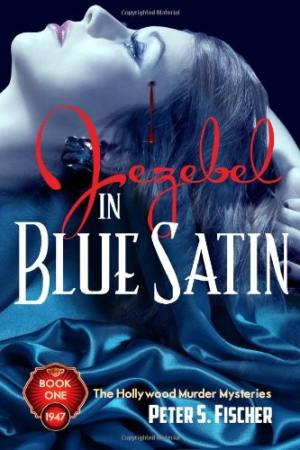Jezebel in Blue Satin
The Hollywood Murder Mysteries Book One
Former TV writer breathes new life into hard-boiled noir detective genre.
From Peter S. Fischer, a twenty-five-year veteran television writer who helped pen such favorite shows as Columbo and Murder, She Wrote, and two other novels, comes a juicy new series of whodunits, subtitled The Hollywood Murder Mysteries.
The inaugural novel, Jezebel in Blue Satin, set in 1947, finds movie studio publicist Joe Bernardi slumming it at a third-rate motion-picture house running on large egos and little talent. When the ingenue from the film referenced in the title winds up dead, can Joe uncover the killer before he loses his own life?
Fischer makes an effortless transition from TV mystery to page-turner, breathing new life into the film noir hard-boiled detective tropes. Although not a professional sleuth, Joe’s evolution from everyman into amateur private eye makes sense; any bad publicity could cost him his job, so he has to get to the bottom of things. While Joe spies on his ex-wife and researches her new beaus, he does not drown his sorrows in dames and liquor. In fact, he does not even smoke, and remains single throughout the novel, without a consistent love interest, save one night of passion with Lydia.
Like any noir narrator, Joe has a plain-spoken, no-nonsense voice. However, he makes amusing, self-aware remarks, such as, “An idea starts to form in my otherwise infertile, coffee-starved brain,” and “[T]he job suits her like a size 2 silk slip.”
Secondary characters get fleshed out, including Joe’s insecure ex-wife, suspects with nuanced degrees of arrogance, and even the murder victim. Since Joe finds her dead on page one, readers get to know her through the reports of other characters, and because the protagonist himself took a brotherly liking to her. She emerges as a character whose death readers mourn.
The author excels at capturing the era when the end of World War II found studios eager to crank out movies to please a populace tired of fighting. Yet, echoes of the conflict still remain. Joe refers to his stint in the war and guesses what the rank of other characters. The attention to the popular brands of the time and the ghosts of war are little details make Jezebel a splendid period piece that simultaneously remains universal in theme. Everyone dreams of getting their big break in life, and everyone must contend with under-qualified and self-important blowhards along the way.
The pacing builds suspense at a steady rate. When things get convoluted, the author has Joe recapitulate the facts of the case so readers do not become confused. Such summary flows naturally within the context of the story. The eye-catching cover, in which a woman lies on blue material, her face bathed in blue light, gives the book a suitably eerie allure.
The book’s one flaw lies in its occasional grammar mistakes and misspellings. While this book could have benefited from one final proof reading before going to press, the intriguing debut from a mystery veteran represents an auspicious start to a series with great potential.
Reviewed by
Jill Allen
Disclosure: This article is not an endorsement, but a review. The publisher of this book provided free copies of the book and paid a small fee to have their book reviewed by a professional reviewer. Foreword Reviews and Clarion Reviews make no guarantee that the publisher will receive a positive review. Foreword Magazine, Inc. is disclosing this in accordance with the Federal Trade Commission’s 16 CFR, Part 255.

